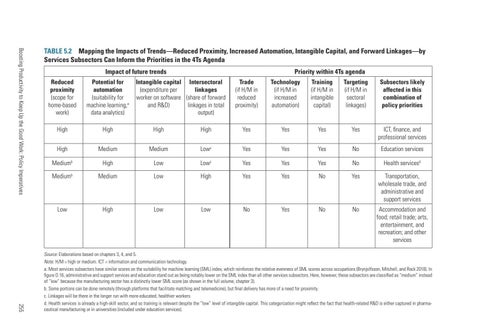Boosting Productivity to Keep Up the Good Work: Policy Imperatives
TABLE 5.2 Mapping the Impacts of Trends—Reduced Proximity, Increased Automation, Intangible Capital, and Forward Linkages—by Services Subsectors Can Inform the Priorities in the 4Ts Agenda Impact of future trends
Priority within 4Ts agenda Trade (if H/M in reduced proximity)
Technology (if H/M in increased automation)
Training (if H/M in intangible capital)
Targeting (if H/M in sectoral linkages)
Subsectors likely affected in this combination of policy priorities
High
Yes
Yes
Yes
Yes
ICT, finance, and professional services
Medium
Lowc
Yes
Yes
Yes
No
Education services
High
Low
Lowc
Yes
Yes
Yes
No
Health servicesd
Mediumb
Medium
Low
High
Yes
Yes
No
Yes
Transportation, wholesale trade, and administrative and support services
Low
High
Low
Low
No
Yes
No
No
Accommodation and food; retail trade; arts, entertainment, and recreation; and other services
Intangible capital Intersectoral (expenditure per linkages worker on software (share of forward and R&D) linkages in total output)
Reduced proximity (scope for home-based work)
Potential for automation (suitability for machine learning,a data analytics)
High
High
High
High
Medium
Mediumb
255
Source: Elaborations based on chapters 3, 4, and 5. Note: H/M = high or medium. ICT = information and communication technology. a. Most services subsectors have similar scores on the suitability for machine learning (SML) index, which reinforces the relative evenness of SML scores across occupations (Brynjolfsson, Mitchell, and Rock 2018). In figure O.16, administrative and support services and education stand out as being notably lower on the SML index than all other services subsectors. Here, however, these subsectors are classified as “medium” instead of “low” because the manufacturing sector has a distinctly lower SML score (as shown in the full volume, chapter 3). b. Some portions can be done remotely (through platforms that facilitate matching and telemedicine), but final delivery has more of a need for proximity. c. Linkages will be there in the longer run with more-educated, healthier workers. d. Health services is already a high-skill sector, and so training is relevant despite the “low” level of intangible capital. This categorization might reflect the fact that health-related R&D is either captured in pharmaceutical manufacturing or in universities (included under education services).

